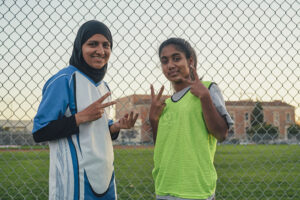Connecting youth in times of disruption
More than 70 million people across the world—more than 1% of humanity—have been displaced by armed conflict, environmental disaster, and other strife. The United States has the largest resettlement program in the world, accepting an average of 60,000 refugees through resettlement over the last decade. Almost half of these were youth, who will face challenges of integration, including language acquisition, social isolation, discrimination, and adjustment to a new educational system. Soccer Without Borders (SWB) uses soccer—the most widely played sport around the world—to create points of connection and pathways to social belonging and personal growth for refugees, immigrants, and other marginalized groups.
Beacon Award Finalist
Among the profiles in this guide are organizations recognized by the University of Pennsylvania’s Lipman Family Prize. The prize is an annual, global prize recognizing leadership and innovation in the social sector. The Prize’s inaugural Beacon Award recognizes past honorees for their success in growing their impact. CHIP works closely with the Lipman Family Prize staff, fellows, and award committee to identify finalists. HOPE and CareMessage were co-winners of the inaugural Beacon Award. Soccer Without Borders, Riders for Health, READ Global and iDE are all honorees who have adapted their important work to the pandemic. To learn more about the prize and past honorees, visit at the Lipman Family Prize site.
What It Does

SWB’s programming includes organized soccer practices and games; academic tutoring and language development; workshops on topics like drug prevention, mindfulness, and healthy relationships; and team, family, and community events to build social capital and enable cross-cultural learning. They currently operate in seven locations serving 3,000 youth from 75 countries speaking 59 languages.
In addition to their own programming, SWB is a sector leader in sport for youth development, coaching other organizations on their model and forming partnerships both locally with schools and refugee resettlement agencies, and internationally with organizations like the U.S. Department of State and FIFA. They have trained coaches and delivered programming in 14 different countries, and are focused on formalizing this knowledge sharing work as a key element of their impact strategy. Based on the UN’s Sustainable Development Goals, their Global Goal 5 accelerator program provides organizations and female soccer coaches from East Africa, Europe, Central and South America, and the U.S. with tools and strategies to increase girls’ participation, strengthen female leadership, and build more gender inclusive organizations.
When COVID-19 made in-person activities impossible for Soccer Without Borders, the organization emphasized that soccer is only a vehicle for its more important impact goal of social inclusion, achieved by putting youth first and forming meaningful relationships. As schools, parks, and leagues closed, SWB’s direct service staff were in regular contact with participants. Nearly 700 participants engaged in mentoring programs and 900 families were reached by food deliveries and referrals. The organization immediately shifted to online programming, leveraging social media and creative activities. SWB launched a “Stay Home Season,” including virtual training sessions, skill challenges, and a social impact challenge that 120 teams competed in. Their Virtual Summer Academy engaged 575 participants with an average of 40 hours of English language development, and 15 hours of fitness activities over a five-week program. SWB also stepped up its advocacy, co-authoring a letter about addressing youth isolation during the crisis that has now been signed by 100 different organizations around the world.
How Effective It Is
Soccer Without Borders reaches youth who typically lack access to out-of-school activities due to linguistic, economic, cultural, and logistical barriers. In 2019, 96% of participant said they made a friend from another culture, and 93% said they accept people who are different from them. 92% of participants said SWB helps them to be healthy. 95% said their coach is a good role model. While 97% of participants speak a language other than English at home, 90% felt comfortable speaking English at SWB. On average Soccer Without Borders retains 76% of participants from one year to the next.
SWB also tracks their impact on educational outcomes. They have a 95% high school graduation rate for regular U.S. program participants, compared to about 62% of English language learners in states where they operate. 90% of SWB participants go on to 2- or 4-year colleges. In Nicaragua, 85% of program participants advance to their next year of schooling, while only 55% of students nationwide complete primary school.
How You Can Help
Soccer Without Borders programs are free to participants, nearly all of whom qualify for free or reduced lunch. Donate on the SWB website; $100 supports one newcomer youth in an SWB USA program for one month, with access to 24-40 hours of activities. A donation of $75 supports one team game day, including healthy snacks and materials for a safe and inclusive event. A donation of $35 provides the full range of SWB activities to one SWB Nicaragua or SWB Uganda participant for one month, with access to 40-70 hours of activities.
More Ways to Help — To help at-risk youth beyond those just in the foster care system, consider Youth Guidance’s Becoming a Man (BAM) and Working on Womanhood (WOW) programs, which have served more than 8,000 youth throughout Boston and Chicago. To help refugees around the world, International Rescue Committee works with refugees in 40 countries, including the U.S., Greece, Italy, Syria, and Yemen.
